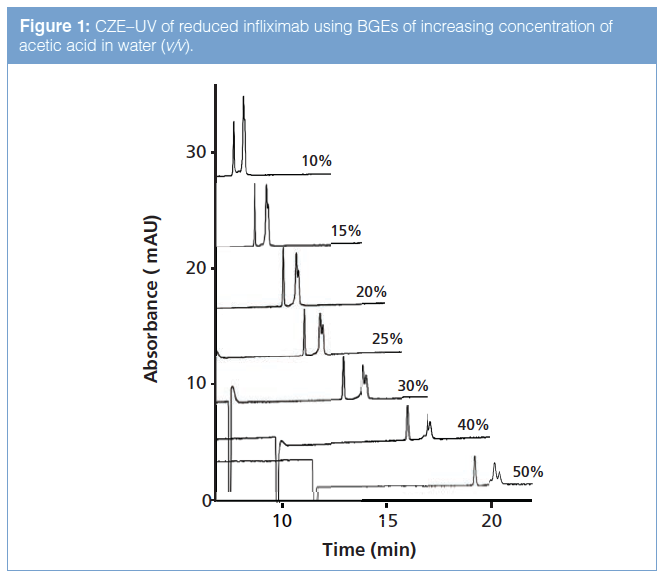Hydrophilic Interaction Liquid Chromatography: An Update
LCGC Europe
This article is an update on the technique of HILIC and covers recent ideas on the mechanism of separation, and how it may be manipulated to suit the separation of particular sample types. The advantages of HILIC are discussed, and also the actual and perceived disadvantages of the technique and how the latter can be overcome. Some new applications of HILIC for characterization of biopharmaceuticals, where it can even be applied to the separation of intact proteins, and to applications in metabolomics, will be discussed.
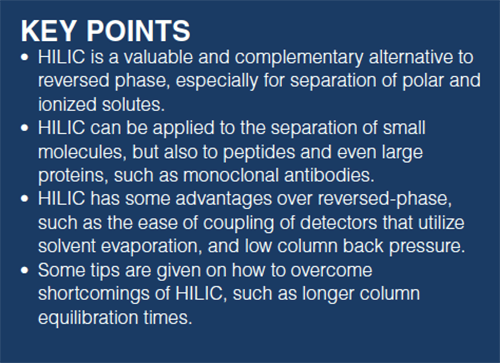
This article is an update on the technique of hydrophilic interaction liquid chromatography (HILIC) and covers recent ideas on the mechanism of separation, and how it may be manipulated to suit the separation of particular sample types. The advantages of HILIC are discussed, and also the actual and perceived disadvantages of the technique and how the latter can be overcome. Some new applications of HILIC for characterization of biopharmaceuticals, where it can even be applied to the separation of intact proteins, and to applications in metabolomics, will be discussed.
It is now almost 30 years since the publication of Alpert’s landmark paper that named the technique of hydrophilic interaction liquid chromatography (HILIC) and discussed its mechanism and applications (1). Alpert clearly recognized that separations were influenced by the partition of solutes between a water layer held on the surface of a polar column and the bulk mobile phase rich in an organic solvent such as acetonitrile. Additional mechanisms, such as ionic retention and adsorption, can be superimposed on this process. Retention increases with increasing polarity of the solute, broadly opposite to that in reversed phase. Nevertheless, there are considerable differences in the selectivity of the techniques, indicating their complementary nature and orthogonality, which is also an advantage for two-dimensional (2D) separations. Polar solutes are retained in HILIC that have little or no retention in reversed phase; for example uracil can show good retention in HILIC, whereas it is used as a void volume marker in reversed-phase chromatography.
There are many advantages of HILIC over reversed-phase chromatography; indeed, for some polar neutral solutes, there is hardly an alternative to HILIC to achieve sufficient retention for separation. However, there are real and perceived disadvantages of HILIC that can provide a barrier to more widespread uptake of the technique. The aim of this paper is to provide an update on the mechanism of separation of HILIC, to discuss the manipulation of its selectivity, its advantages and limitations (and how they may be overcome), together with some new applications of the technique.
Which Solutes are Suitable for HILIC?
Polar and ionized solutes that are hydrophilic are likely to be retained in HILIC; as a guide, the log of the solute distribution ratio between octanol and water can be considered where:

Log Dow values can be measured experimentally, or obtained from a number of commercial simulation software packages. Hydrophobic solutes have a high positive log D value, that is, they prefer to partition into the relatively nonpolar (octanol) in a shake flask experiment (this simulates the bulk mobile phase in HILIC), and thus they are less retained. Conversely, very hydrophilic solutes have a large negative value (prefer to partition into water) and thus are more retained. Typically, solutes with a value of log D > ~+1 will show low retention in HILIC. However, ionic effects can contribute to retention; for example, the protonated base nortriptyline (log D ~+1) gives high retention on a silica column using aqueous acetonitrile buffered at ww pH 3 because of interaction with negatively charged silanols (2). Figure 1 indicates a rough correlation on three HILIC stationary phases between log Dow and retention for some acidic, basic, and neutral solutes. The correlation is best for TSK amide (r = 0.83), which has a thick neutral polymer layer that shields stationary phase silanol groups (negatively charged) from ionic retention of protonated bases or repulsion of charged acids. The bare silica column shows no such shielding from ionic effects, resulting in a much poorer correlation (r = 0.42). Clearly, the retention of neutrals by partition should depend on the extent of the water-rich layer on the surface, while ionic retention–repulsion and adsorption effects will also depend on the particular stationary phase used. These factors contribute to the substantial selectivity obtainable by changing the stationary phase in HILIC (see below).

Whereas HILIC has classically been applied to small molecules, it has recently been successfully applied to the separation of peptides and even intact proteins (see below).
The Mobile Phase in HILIC
Organic Solvent Concentration: The ratio of organic solvent to water in the mobile phase is a crucial factor in controlling overall retention in HILIC. Reducing the water (the strong solvent) concentration increases retention, which is the opposite effect to that in reversed phase. Retention can increase exponentially at high levels of acetonitrile (80–95%) (3). Although other water-miscible polar organic solvents have also been used (such as methanol), acetonitrile is by far the most commonly employed, and usually in the concentration range ~ 60–95%. As the water concentration increases in the mobile phase, polar solutes increasingly partition into it, reducing retention.
Buffers and Mobile Phase pH:
Approaches to pH Measurement: Buffers are necessary to stabilize the charge both on the solute and the stationary phase. The choice of buffer is relatively restricted as a result of solubility problems in high concentrations of acetonitrile; ammonium formate (AF, ww pKa = 3.75) and ammonium acetate (AA, ww pKa =4.75) are commonly used. In addition to favourable solubility, these buffer salts are volatile and thus useful for mass spectrometry (MS) detection. High concentrations of acetonitrile do, unfortunately, influence pH measurement. Typically, pH is measured in the aqueous component of the mobile phase (ww pH), but is more informatively measured after addition of the organic solvent, directly in the final mixture (ws pH). This measurement (by use of published delta “correction” factors) can be related to the true thermodynamic pH of the solution (ss pH):

The ss pH ultimately determines the retention properties of the solute in the system. Correspondingly, the ionization of buffers is also governed by their ss pKa values. Unfortunately, these values are rarely available, leading to the widespread adherence to the (less correct and less informative) ww pH and ww pKa values. This difficulty can be considered a disadvantage of the HILIC technique because it complicates interpretation and prediction of retention.
Effect of Buffer pH: McCalley studied the use of volatile AF, AA, and ammonium bicarbonate buffers at ww pH 3.0, 4.4, 6.0, and 9.0 for the analysis of acidic, neutral, and basic solutes on a relatively inert amide column, containing a low concentration of acidic silanols and a neutral bonded ligand (see Figure 2). The neutral solutes, thiourea (peak 3) and uracil (peak 4), showed little variation in k over the entire pH range. The bases, procainamide and nortriptyline (peaks 5 and 6), gave increased retention as the pH was increased from 3 to 6. It is possible that increased silanol ionization over this range produces increased ionic retention of these basic solutes. At pH 9, however, their retention dropped, probably as a result of suppression of solute ionization and thus diminution of ionic attraction. The strong sulfonic acids (peaks 1 and 2) showed little retention, which further decreased as the pH was raised from 3 to 9, attributable to increased solute repulsion of these fully ionized acids from increasingly ionized silanols as the pH was raised. The weak acid 4-hydroxybenzoic acid (peak 7) showed increased retention as the pH was raised from 3 to 6. The increase in pH causes increased solute hydrophilicity, reflected in a decreased log D value as the solute was increasingly ionized. It may also encourage hydrogen bonding between ionized acidic solute and neutral polar column groups. However, at pH 6 the acid was mostly ionized and repulsion effects from increasingly ionized silanols dominated, causing reduced solute retention at pH 9. The retention of many weak acids on silica-based columns can be explained by a balance of the opposing effects of increased ionization and hydrophilicity against increased repulsion as the pH is raised (4).

Changing the mobile phase pH is a powerful means of adjusting the selectivity in a HILIC separation even when restricting the choice to volatile “mass spectrometer-friendly” buffer systems.
Effect of Buffer Concentration: An increase in volatile buffer concentration of AA or AF tends to increase the retention of neutral compounds. This result may be a result of the salt increasing the volume of water in the stationary phase layer, a selective process that may depend on the nature of the salt. For basic compounds, retention decreases with increasing buffer concentration on silica-based columns, as a result of the competitive interaction of the buffer cation with ionized stationary phase silanols. Conversely, the insulating effect of buffer ions on charged silanols results in reduced repulsion from the column and a higher retention of acidic solutes. Clearly, ionic interaction effects (both attractive and repulsive) could be minimized-or in some cases even eliminated-by the use of high buffer concentrations, although their deliberate suppression is questionable because they can give rise to useful selectivity effects. In addition, high buffer concentrations are undesirable for use in liquid chromatography (LC)–MS because they can suppress solute ionization and thus reduce detection sensitivity (3).
Alternative Buffers to AA and AF: Simple organic acid additives, such as 0.1% formic and acetic acid, have been employed instead of salt buffers because they give reduced ion suppression effects in MS; unfortunately, they can give poor peak shapes for some acidic and basic solutes. The inferior peak shapes may be a result of the very low ionic strength of simple acids, especially in high concentrations of acetonitrile, causing overloading effects even at relatively low solute concentrations (5). These effects may be in addition to the lack of deactivating effect of the ammonium ion (present in the usual salt buffers) on ionized silanols. Stronger acids (for example, 0.1% trifluoroacetic acid [TFA]) give access to lower ws pH values while retaining sufficient ionic strength in high concentrations of acetonitrile to yield satisfactory peak shapes (6). TFA may also improve peak shape through ion pairing effects. TFA gives unusually increased retention of strongly acidic solutes on silica-based columns partially as a result of reduction of silanol repulsion. In addition, the column surface may become positively charged, attracting anionic solutes (see Figure 3).

Alpert explored a much more diverse series of buffer compounds, including nonvolatile salts that are not suitable for mass spectrometry (7). In particular, he aimed to study the effects on retention of kosmotropic ions, such as sulfate, which are well hydrated, and chaotropic ions, such as perchlorate, which are poorly hydrated. The former was found to promote partitioning of charged solutes into the immobilized aqueous layer. The effects on neutral solutes were more modest; retention times were unchanged or increased slightly with an increase in concentration of any salt. Concentrations of salt ranged from 5–120 mM at ww pH values of both 3 and 6.
The Stationary Phase
Stationary phases can be divided broadly into those that have an essentially neutral surface, for example, amide or diol; those that have an acidic surface, for example, poly(2âsulfoethyl), which possesses sulfonic acid groups; and those that are basic, for example, those with alkyl amino groups. There are also other categories, such as zwitterionic columns, that can behave in a somewhat similar way to neutral columns because of the proximity of negatively and positively charged ligands (but with some superimposed ionic retention behaviour). Bare silica columns are another distinct group that show acidic properties because of the presence of negatively charged silanol groups, particularly at higher pH. Principal component analysis (8) or correlation analysis considering retention data for different probe solutes has demonstrated that columns in these various categories show distinct retention behaviour.
The retention of neutral solutes is influenced by partitioning into the water layer on the column surface and it is therefore hardly surprising that their retention is affected by the thickness of this layer, which varies on different columns. Commercially available polymeric zwitterionic phases have an extensive water layer, which may result from their thick layers of bonded polymeric stationary phase ligands. In comparison, diol phases and silica hydride have thinner water layers. Adsorption may be a more important mechanism here, especially on the latter phase. Neutral solute retention is affected by water layer thickness and can be assessed by measuring the hydrophilic selectivity of the phase αOH (9):

Dexyuridine has one less –OH group than uridine, resulting in less hydrophilicity and reduced retention compared with uridine. Measurements of this parameter show a broad correlation with estimates of water layer thickness (2). For example, using 5-mM AF pH 3.0 in 95% acetonitrile gave αOH as 1.6, 2.3, and 3.0 for a bare silica, amide, and zwitterionic phase, respectively. Clearly, the zwitterionic phase should give the greatest retention of neutral solutes.
The propensity of a phase to retain cationic solutes over neutral solutes can be assessed by measuring its cationic selectivity α CXT:

where TMPAC is trimethylphenylammonium chloride, a quaternary salt that is ionized under all conditions. Using 5-mM AF in 85% acetonitrile, silica, zwitterionic, diol, and amide columns gave values of 7.1, 1.0, 0.6, and 0.5, respectively, for this parameter, demonstrating considerable preferential retention of cationic solutes on bare silica. Similarly, the anionic selectivity of columns can be measured from:

where BSA is the strong acid benzenesulfonic acid. Once again when using 5-mM AF in 85% acetonitrile, amino and amide columns gave values of 6.6 and 0.33, respectively, demonstrating the considerably increased selectivity for acids of the amino phase (4).
Changing the stationary phase is probably the most effective way to change the selectivity of the separation (2), as shown in Figure 4 for neutral uridine, the acid 4 –hydroxybenzoic acid, and the base nortriptyline (10). Both bare silicas show preferential retention of nortriptyline because of attractive interactions with negatively charged silanols. The low pore occupancy of water in silica columns (7–9% in 89% acetonitrile [11]) and their poor hydrophilic selectivity explains their low retention of uridine. Bonded phases have fewer silanols, which may in addition be partially shielded, resulting in low retention of nortriptyline on the zwitterionic and amide phases. Reduced silanol interactions and good hydrophilic selectivity on these phases may also explain their improved retention of neutral and acidic probes. A “toolbox” of phases of different selectivity might first contain the neutral and quasi-neutral amide and zwitterionic columns, which are good “generalâpurpose” phases. A bare silica column or phase containing bonded acidic groups (for example, sulfonic acid) should be included to give good retention or separation of bases and an amino column could be used for the separation of acids. The substantial variation in selectivity between different columns in HILIC is an advantage over reversedâphase methods, where interchange of stationary phases has a relatively smaller effect on selectivity.
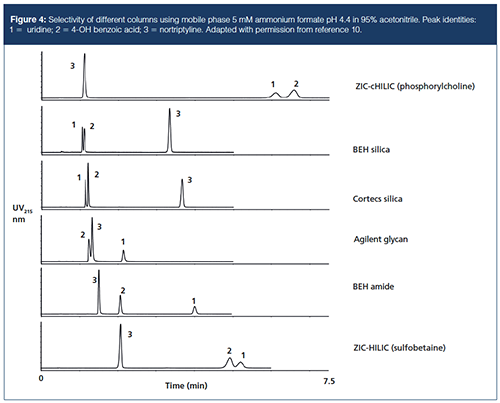
Advantages of HILIC
As well as the high retention of polar and ionized compounds, the complementary nature to reversed-phase chromatography, and the beneficial changes in selectivity of different stationary phases, HILIC demonstrates a number of other advantages over reversed-phase chromatography.
Low Viscosity of the Mobile Phase: Many of the advantages of HILIC stem from its use of high concentrations of acetonitrile (typically 60–95%) in the mobile phase, giving low viscosity, and allowing the use of long columns, or fast flow with conventional columns. A 45 × 0.46 cm column packed with 2.7-µm shell particles operated at a flow of 2.0 mL/min generated over 100,000 theoretical plates for four basic drugs in a reasonable analysis time (<15.0 min) (12). For solutes amenable to either HILIC or reversed phase (such as moderately hydrophobic base nortriptyline), the organic-rich mobile phase used in the former technique provides increased solute diffusion and thus flatter van Deemter curves in the C-term region (mass transfer). However, if the increase in solute diffusion is factored out using reduced plots, reversed phase shows a slight advantage in the C-term region at fast flow rates. This means that a somewhat improved performance at high flow rates is obtained for hydrophobic solutes using reversed phase rather than hydrophilic solutes using HILIC (13). However, HILIC is clearly favoured in many cases by the possibility of longer columns (at normal or reduced flow) to generate high efficiency.
Peak Shape of Ionogenic Compounds: Peak shapes of basic compounds can be surprisingly good in HILIC. The basic drugs diphenhydramine, procainamide, and nortriptyline gave excellent peak shapes using a bare silica column with a simple AF buffer pH 3 in acetonitrile. This column has a high cationic selectivity; in reversedâphase chromatography, strong ionic interactions can be associated with poor peak shape, which is not always true in HILIC. Good peak shapes may be associated with higher sample capacity in HILIC, with column efficiency being maintained at much higher solute mass than in reversed phase (14).
Compatibility with Electrospray Ionization (ESI)-MS and Other Evaporative Detectors: The low viscosity, high volatility, and low surface tension of high concentrations of acetonitrile are conducive to higher sensitivity in ESI-MS (15).
Figure 5 compares the relative signal-to-noise (S/N) ratio for six basic and four acidic solutes by flow injection analysis (FIA) ESI-MS using a triple quadrupole MS and multiple reaction monitoring (MRM) conditions optimized for each solute. On average, a sensitivity increase of ~3× for the HILIC conditions (90% acetonitrile–10% 5 mM AF pH 3.0) compared with reversed-phase conditions (10% acetonitrile–90% 5 mM AF pH 3.0) was obtained. The use of FIA avoids introduction of the samples into a chromatographic surface, which potentially might confound the results with adsorption effects. Gradient elution of mixtures of solutes using an appropriate column can also be used to assess difference in detection sensitivity. While possible column adsorption effects may indeed confound the results, as well as possible elution in different mobile phase composition (dependent on the column), this method can be used to evaluate the response of solutes in mixtures simultaneously, as they can be separated on the column. As FIA has no separation stage, solutes are best evaluated individually, making the procedure more laborious. It also arguably presents a more realistic simulation of normal experimental conditions. The average gain in sensitivity was reported as 7–10 times (16), but improved modern interface designs showed more modest gains (17). Similar beneficial increases in sensitivity can be obtained with other mobile phase evaporation detectors, such as the charged aerosol detector (18).
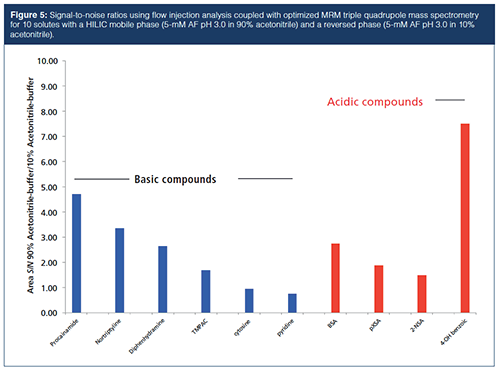
Disadvantages of HILIC and How They May be Overcome
Sample Injection: Using injection solvents of higher eluotropic strength than the mobile phase (that is, increased water concentration) gives increasing deterioration in peak shape (19). This effect can be problematic if the sample is not soluble in high concentrations of acetonitrile (that is, in appropriately “weak” mobile phases). The effect can be moderated by injecting small volumes. Alternatively, for small-molecular-weight (MW) compounds, isopropyl alcohol (IPA) or a mixture of 50:50 acetonitrile–IPA has been recommended. For drug discovery applications, dimethylsulfoxide in at least 80% acetonitrile can be used, whereas for peptide analysis, pure ethanol or IPA is possible (20).
Use of the mobile phase or a weaker solvent as an injection solvent to avoid peak distortion is not normally possible with biopharmaceuticals because of limited solubility in high concentrations of acetonitrile and possible protein denaturation or precipitation. Therefore, in one study, an aqueous sample was injected followed by a fast gradient ramp incorporating a high percentage of acetonitrile at the beginning of the method, in addition to a small injection volume (21), which produced good results.
Long Equilibration Times: Full isocratic equilibrium of the column (where retention times stabilized to 99–101% of the value at “infinite” equilibration time), with buffered acetonitrile mobile phase, can require more than 20 min (> 40 column volumes) when purging the 10× 0.21-cm columns at 0.5 mL/min (10). In isocratic analysis, full equilibration is necessary because the selectivity of the separation can change with equilibration time. Full equilibration was found to depend on the nature of the HILIC stationary phase, the purging flow rate, and the original or “storage” solvent. These long equilibration times are not, however, a barrier to the use of gradient elution in HILIC. In gradient elution, a repeatable partial equilibrium was demonstrated (10) in an equilibration time of as little as 5 min, implying that HILIC can be reliably used under these conditions. Selectivity changes can occur in the separation dependent on the particular equilibration time between gradient runs. Therefore, this parameter must be kept constant in a series of analyses; however, this does not appear to be a problem when using modern HPLC instruments.
Retention Time Instability and Drift: HILIC has sometimes been found to suffer from irreproducible or drifting retention times. This problem is often associated with insufficient equilibration of the column (see above), especially in isocratic applications. However, one study found retention time irreproducibility was associated with storage of the (organicârich) mobile phase while connected to the instrument, rather than in tightly sealed bottles, which gave excellent day-to-day repeatability of retention (22).
Extra care may be necessary in mobile phase preparation. The commonly used buffer salts AF and AA are hygroscopic and should be stored in a dessicator at room temperature to improve reproducibility of buffer preparation. For isocratic analysis using high concentrations of acetonitrile (low concentrations of water), some consideration should be given to preparing the mobile phase by premixing aqueous and organic liquids by weight, taking into consideration the density of the liquids. Errors might otherwise result if metering relatively small volumes of aqueous phase using the HPLC instrument.
In gradient analysis, particularly with high-pressure mixing systems that use a separate pump for each solvent flow, the use of one channel delivering small volumes (difficult to achieve reproducibly and accurately) throughout the gradient run should be avoided. This is especially true when the total flow is relatively low, which is necessary with a smallâdiameter column, and when a relatively shallow gradient is employed, as is often the case with HILIC. Therefore, a gradient from 90% to 80% acetonitrile is best not devised with bottle A containing 90% acetonitrile and bottle B 0% acetonitrile at a total flow of 0.4 mL/min. This would result in pump B delivering only ~0.045 mL/min, even at its maximum flow at the end of the gradient.
Some New Applications of HILIC
Analysis of Glycans “Bottom-Up” Methods: HILIC has established itself as an essential technique for monitoring glycans in monoclonal antibody (mAb) drugs designed to target specific antigens. mAbs have MW ~150,000, of which about 5% by weight can be glycans. Much analytical work needs to be performed in the characterization of mAbs or their biosimilars that have similar efficacy and safety to the original drug, or biobetters, which are improved products. Many of the original biopharmaceuticals are coming off patent, giving scope for the development of these substitute drugs. Glycosylation is one of the important causes of microheterogeneity caused by post-translational modification (PTM) that can occur, for example, during production and storage; thus, its characterization is of great importance to enable potential differences in the products to be assessed.
About ten sugars are commonly found as constituents of glycans, which may be attached to the Fc fragment of the mAb. A glycan is a mono-, poly-, or oligosaccharide, but typically contains ~10 monosaccharides. N-glycans can be cleaved from the mAb by an enzyme, such as PNGaseâF. The resulting free N-glycans can be analyzed in their native state or reacted with 2-amino benzamide (2-AB) or procainamide to give sensitive fluorescent derivatives. However, 2-AB derivatives are difficult to detect by ESI-MS because of poor ionization efficiency. An alternative derivative after PNGase-F deglycosylation, which apparently gives both good fluorescent and ESIâMS sensitivity, has recently been proposed (23). In addition to releasing N-glycans from IGg Fc domains, the proposed approach also produced complete release of Fab domain N-glycans. Gradient elution analysis on a wide-pore (300 Å) amide column was used in their analysis. Complete release of N-glycans from Fab domains was obtained using this procedure with HILIC–MS, showing a peak of mass 148.4 kDa before deglycosylation and 145.3 kDa after, implying the loss of two N-glycans.
Characterization of Intact or Large Fragment Protein Biopharmaceuticals and mAbs: Guillarme and co-workers (24) employed a wide-pore sub-2-µm amide HILIC column to successfully characterize intact and digested (25–100 kDa fragment) protein biopharmaceuticals using gradients of 65–80% acetonitrile and 0.1% TFA. The 300-Å pore size packing allowed the accommodation of large biomolecules and fragments without resulting in restricted diffusion. The separations were reported to be highly orthogonal to reversed-phase LC, while the kinetic performance remained comparable. The authors stressed the following advantages of HILIC: i) compatibility with MS, ii) reduced requirement of high temperatures that are necessary in reversed-phase LC to limit undesirably strong adsorption, and iii) the possibility of coupling columns in series to gain extra resolving power. Applications were shown to the analysis of six different insulins (one of the oldest biopharmaceuticals, RMM~6000); reversed-phase LC and HILIC were shown to be complementary, with better separation of insulin and insulin glulisine by HILIC, but superior separation of insulin and insulin lispro by reversed-phase chromatography. High efficiencies were obtained in both (isocratic) analyses. The authors compared characterization of trastuzumab by HILIC, reversed phase, and ion exchange, even gaining some results with intact proteins, although reduction of disulphide bonds prior to chromatography or partial digestion of the mAb typically yields better results in terms of both chromatographic and mass spectrometry characterization. Trastuzumab (Herceptin) is a mAb widely used for the treatment of some types of breast cancer. Whether these large molecules are denatured during separation (which should still allow for their analytical-if not their preparative-separation, retaining their biological activity) remains to be confirmed.
HILIC–MS was used to compare originator and biosimilar therapeutic mAbs at the intact and the so-called “middleâup” level of analysis, again using a wide-pore 300-Å amide column (21). While “bottom-up” analysis (where the sample is processed to give the simplest building blocks, for example, liberated peptides or glycopeptides) is most often used as the subsequent analysis of these smaller molecules is easier, it loses structural information on these complex molecules. In the HILIC analysis, 0.1% TFA was again used as mobile phase additive, even though it can cause some ion suppression in MS detection. It was preferred due to its solubilizing effect on proteins and its low pH suppression of silanol ionization. The intact mAb was digested, then reduced to give Fd’, light chain (LC), and Fc/2 subunits (two of each) of about 25 kDa, containing attached intact glycans, and then subjected to reversed-phase and HILIC analysis. The two techniques were complementary, as can be seen in Figure 6, which shows middle-up separations of Trastuzumab (Herceptin) and its biosimilar Trastuzumab B. Reversed-phase analysis gave a separation of the three main fragments, but offered information about the glycosylation pattern only after examination of the MS data. In contrast, HILIC–MS on the same sample allowed for a direct and immediate comparison of the glycosylation profiles. Furthermore, Guillarme (25) demonstrated the use of HILIC coupled with MS to characterize the antibodyâdrug conjugate (ADC) Brentuximab vedotin, which is used in the treatment of Hodgkin’s lymphoma. ADCs enable the delivery of cytotoxic drugs (present in this case with an average drug-to-antibody ratio of four) to therapeutic targets with an antibody-directed mechanism. As with mAbs, these materials need to be characterized because of the structural complexity and heterogeneity. A middle-up approach with fragment (~25 kDa) analysis using a 300-Å amide column and a gradient of 85–73% acetonitrile with 0.08% TFA and 0.02% formic acid was used. It was found that HILIC analysis offered a completely complementary and orthogonal set of information to reversed-phase analysis; elution order was essentially the opposite to that observed in reversed phase. Only one HILIC–MS run was necessary to obtain highly important information on structural microheterogeneity.
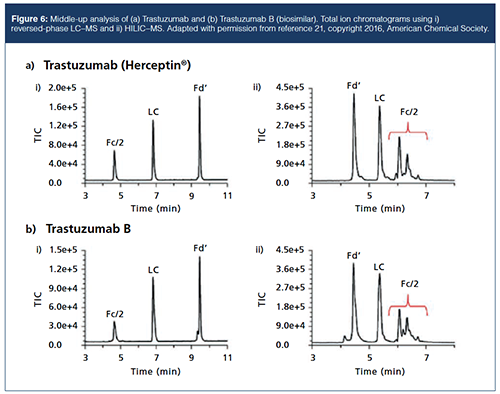
HILIC in Metabolomics: The human metabolome consists of small molecules-generally accepted as having a MW <1500 Da-dictated by the genes of the individual and also the individual’s environment, and therefore it consists of a mixture of endogenous and exogenous compounds. Whereas nuclear magnetic resonance (NMR) spectroscopy provides standard analytical methodology common to most samples and does not require analytical development, it suffers from spectral overlap and low sensitivity. Thus, MS, which is considerably more sensitive, coupled with separation techniques such as gas chromatography (GC) and LC provides a valuable alternative to NMR. LC clearly has broader application possibilities than GC because it is amenable to nonvolatile, highly polar, and thermally labile samples without derivatization. The complementary use of HILIC and reversed-phase chromatography coupled with MS expands the number of detected analytes and provides considerably more comprehensive analyte coverage (26). Important classes of compound that have been analyzed by HILIC include phospholipids, which are the main constituents of biological membranes. They are important signalling molecules and potential biomarkers for ovarian cancer, diabetes mellitus, and other conditions. They consist of a polar phosphate head group, two fatty acid chains, and a glycerol group. HILIC eluents are more compatible with ESI-MS than normal-phase chromatography eluents, which are traditionally used for these solutes. Typical mobile phases are acetonitrile containing AA or AF buffers, in conjunction with bare silica or diol columns. Organic acids, sugars, amino acids, nucleosides, and nucleotides, which can be biomarkers of inherited metabolic disease, are other examples of metabolites amenable to HILIC. A comparative study of the analysis of 764 metabolites using either HILIC or reversedâphase analysis showed that HILIC methods markedly improved the coverage of polar metabolite groups, such as phosphates or carbohydrates, and therefore represented a worthy alternative to reversedâphase separations (27). Zwitterionic sorbents, such as those containing sulfobetaine groups, had a particular broad application range. In addition, selectivity was highly diverse among the HILIC methods investigated (which used different stationary phases). For example, an amide column gave good retention of nucleosides, whereas a phophorylcholine sorbent was most appropriate for the separation of carbohydrates.
A further advantage of HILIC over reversed phase in metabolic studies appears to be that glycerophospholipids, generally observed in cell and plasma samples, tend to appear in narrow retention time ranges instead of covering major parts of the retention window, which is often found for reversed-phase separations (28). These compounds give extensive ion suppression in ESI-MS. For analysis of a broad range of metabolites, the risk of suppression increases with increased spreading of the retention window of the interferents. In the same article, considerable differences in selectivity for metabolites and matrix interferents were shown between bare silica, zwitterionic, and amide HILIC stationary phases. Thus, a particular HILIC column may be the optimum for each individual application.
Conclusions
HILIC has become an indispensable technique for the analysis of polar and ionized solutes poorly retained by traditional reversed-phase methods. For samples amenable to both HILIC and reversed-phase analysis, the techniques show a complementary nature. In fact, for such samples, the use of HILIC may be advantageous because of the favourable coupling with MS and other evaporative detectors, the low viscosity of the mobile phase (allowing the use of long columns), and good peak shapes for some basic pharmaceuticals.The mechanism of HILIC separation, however, appears complex, which can pose a barrier to the more widespread adoption of the technique. Nevertheless, a greater understanding of the effect of some simple parameters could lead to more straightforward method development. Problems such as longer equilibration times are not a barrier to the use of gradient methods. Some new applications, such as the characterization of biopharmaceuticals, and its use in metabolomics, indicate good potential for the use of the technique in these areas, where it is complementary to reversed-phase methodology.
References
- A.J. Alpert, J. Chromatogr.499, 177–196 (1990).
- A. Kumar, J.C. Heaton, and D.V. McCalley, J. Chromatogr. A1276, 33–46 (2013).
- D.V. McCalley, J. Chromatogr. A1523, 49–71 (2017).
- D.V. McCalley, J. Chromatogr. A1534, 64–74 (2018).
- J.C. Heaton, J.J. Russell, T. Underwood, R. Boughtflower, and D.V. McCalley, J. Chromatogr. A1347, 39–48 (2014).
- D.V. McCalley, J. Chromatogr. A1411, 41–49 (2015).
- A.J. Alpert, J. Chromatogr. A1538, 45–53 (2018).
- N.P. Dinh, T. Jonsson, and K. Irgum, J. Chromatogr. A1218, 5880–5891 (2011).
- Y. Kawachi, T. Ikegami, H. Takubo, Y. Ikegami, M. Miyamoto, and N. Tanaka, J. Chromatogr. A1218, 5903–5919 (2011).
- D.V. McCalley, J. Chromatogr. A1554, 61–70 (2018).
- N.P. Dinh, T. Jonsson, and K. Irgum, J. Chromatogr. A1320, 33–47 (2013).
- D.V. McCalley, J. Chromatogr. A1193, 85–91 (2008).
- J.C. Heaton, X. Wang, W.E. Barber, S.M. Buckenmaier, and D.V. McCalley, J. Chromatogr. A1328, 7–15 (2014).
- D.V. McCalley, J. Chromatogr. A1171, 46–55 (2007).
- S.R. Needham, P.R. Brown, K. Duff, and D. Bell, J. Chromatogr. A869, 159–170 (2000).
- A. Periat, J. Boccard, J.L. Veuthey, S. Rudaz, and D. Guillarme, J. Chromatogr. A1312, 49–57 (2013).
- A. Periat, I. Kohler, A. Bugey, S. Bieri, F. Versace, C. Staub, and D. Guillarme, J. Chromatogr. A1356, 211–220 (2014).
- J.J. Russell, J.C. Heaton, T. Underwood, R. Boughtflower, and D.V. McCalley, J. Chromatogr. A1405, 72–84 (2015).
- J.C. Heaton and D.V. McCalley, J. Chromatogr. A1427, 37–44 (2016).
- J. Ruta, S. Rudaz, D.V. McCalley, J.L. Veuthey, and D. Guillarme, J. Chromatogr. A1217, 8230–8240 (2010).
- V. D’Atri, S. Fekete, A. Beck, M. Lauber, and D. Guillarme, Anal. Chem.89, 2086–2092 (2017).
- N. Gray, J. Heaton, A. Musenga, D.A. Cowan, R.S. Plumb, and N.W. Smith, J. Chromatogr. A1289, 37–46 (2013).
- M.A. Lauber, Y.Q. Yu, D.W. Brousmiche, Z. Hua, S.M. Koza, P. Magnelli, E. Guthrie, C.H. Taron, and K.J. Fountain, Anal. Chem.87, 5401–5409 (2015).
- A. Periat, S. Fekete, A. Cusumano, J.L. Veuthey, A. Beck, M. Lauber, and D. Guillarme, J. Chromatogr. A1448, 81–92 (2016).
- V. D’Atri, S. Fekete, D. Stoll, M. Lauber, A. Beck, and D. Guillarme, J. Chromatogr. B Analyt. Technol. Biomed. Life Sci.1080, 37–41 (2018).
- D.Q. Tang, L. Zou, X.X. Yin, and C.N. Ong, Mass Spectrom. Rev.35, 574–600 (2016).
- S. Wernisch and A. Pennathur, Anal. Bioanal. Chem.408, 6079–6091 (2016).
- A. Elmsjo, J. Haglof, M.K. Engskog, I. Erngren, M. Nestor, T. Arvardsson, and C. Pettersson, J. Chromatogr. A1568, 49–56 (2018).
David McCalley is Professor of Bioanalytical Science at the University of the West of England, Bristol. He is a past winner of the Silver Jubilee medal of the UK Chromatographic Society. In the past three years, he has given invited lectures in London, San Francisco, Cork, Paris, Prague, Balaton, Sandefjord, Cannes, and Princeton. His research is directed towards the understanding of the fundamental separation mechanisms that occur in liquid chromatography. These studies have included the effects of pressure on separations, superficially porous packings, overloading, reversed-phase, and hydrophilic interaction chromatography.

Assessing Thorium-Peptide Interactions Using Hydrophilic Interaction Liquid Chromatography
February 4th 2025Paris-Saclay University scientists used hydrophilic interaction liquid chromatography (HILIC) coupled to electrospray ionization mass spectrometry (ESI-MS) and inductively coupled plasma mass spectrometry (ICP-MS) to assess thorium’s interaction with peptides.

.png&w=3840&q=75)

.png&w=3840&q=75)



.png&w=3840&q=75)



.png&w=3840&q=75)



